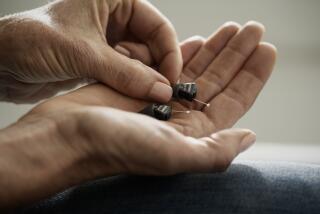‘Bionic Ear,’ Other Devices Bring Sound to the Deaf
- Share via
Technology and medicine are coming to the aid of hearing impaired and deaf people with cochlear implant surgery, FM or infrared transmitters and improved hearing aids.
Perhaps the most exotic is the “bionic ear,” or cochlear implant, that helps profoundly deaf people hear sound and recognize speech.
A tiny receiver is surgically implanted in the bone behind the ear and electrode channels inserted into the cochlea, or inner ear. After surgery, the patient is fitted with an externally worn microphone, transmitter and speech processor. These send sound through the implants to stimulate nerve fibers, which in turn relay messages to the brain.
Range of Pitches Heard
The latest version is a 22-channel implant, which lets the patient hear a broad range of pitches.
Cochlear Corp., which manufactures the devices, says 300,000 people in the United States alone could benefit from cochlear implant technology.
The system, implantation surgery and follow-up rehabilitation currently run around $25,000. Insurance plans or Medicaid cover the cost in many cases.
Infrared and FM devices have greater range and power than conventional hearing aids, helpful in public places and meetings and for television listening. In both types of systems, the user hears sound through a headphone radio receiver.
Volume Adjustable
An infrared system pairs a transmitter, connected to a microphone or directly into a television audio jack, with a headphone worn by the user. Volume can be adjusted on the headphone without disturbing neighbors or other viewers. The microphone-type of transmitter also can be used for room conversation or meetings.
The same headphone can be worn (or borrowed at the site) at many theaters, churches, temples, and other public places where infrared transmitters have been set up. Infrared Listing Systems of New York, for example, has equipped most theaters and concert halls in New York and many others across the country. For the consumer who wants a transmitter and headphone for personal use, costs average from $125 to $150 for each element.
One-on-One System
FM systems have receivers that are custom-tailored to split and re-form frequencies according to the user’s profile. Sound is transmitted from one other person, a speaker wearing a neck microphone. This one-on-one connection cuts background noise, making it a good choice for classroom or meeting use. Cost is approximately $1,000 for the system.
Improved circuitry in hearing aids, the most common devices used by hearing impaired people, has made it possible to get high power in the small in-the-ear instruments. Many aids have dual-channel circuitry that balances high- and low-frequency sounds adjusted to the user’s hearing loss profile.
The dual-channel processing--which splits the frequencies and combines them again in the appropriate proportion--helps the wearer distinguish sounds in noisy environments. Hearing aids have a fairly wide price range--from around $400 up to $1,500.
The user should have a hearing test and consultation with an audiologist or otolaryngologist before choosing either a hearing aid or FM system.
More to Read
Sign up for Essential California
The most important California stories and recommendations in your inbox every morning.
You may occasionally receive promotional content from the Los Angeles Times.












